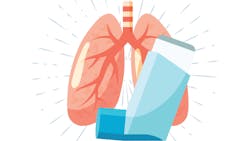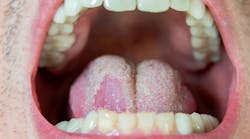Just breathe! Why asthma matters to the dental hygienist (part I)
This is part one of a two-part series. Read part two.
Asthma is a chronic obstructive pulmonary condition that results in inflammation in the airway and thus interferes with the exchange of gases in the lungs. Globally, as of 2018, an estimated total of 339 million people were affected by asthma, with approximately 1,000 deaths reported daily.1 While asthma is more common in children, higher mortality rates are found in adults. Gender is a contributing but also confounding factor; while more boys develop asthma in childhood, more adult women live with asthma.2,3
Why should dental hygienists understand asthma and its causes? Based on the frequency in which asthma is encountered in both children and adults, dental hygienists are likely to encounter patients with asthma in their daily practice. Adequate knowledge and understanding of this disease and its treatment are, therefore, crucial to providing safe and proper care for these patients.
In this two-part column, we will explore the etiology, pathophysiology, and pharmacologic management of asthma. We will also discuss the necessary considerations for promoting good oral health in this population, while reducing the risk of treatment-induced exacerbations.
Etiology of asthma
Although asthma is a chronic condition, the frequency and severity of acute episodes and the patient’s response to triggers are largely idiosyncratic. Patients with asthma will explain that their acute episodes of asthma are often due to certain “triggers” that incite the inflammatory reaction. Studies have consistently demonstrated a strong genetic basis for the development of asthma. Environmental factors lead to increased expression of inflammatory mediators, which play an important role in the pathophysiology of asthma.4,5
Pathophysiology of asthma
One such environmental factor that has been reported as the most common cause of asthma in children and adults is allergic sensitization. Sensitization from prolonged exposure to allergens produces the clinical symptoms of asthma, such as coughing, wheezing, and difficulty breathing.4-6 Other risk factors associated with the onset of asthma include respiratory infections, obesity, smoking, air pollution, occupational exposures, stress, exercise, and gastroesophageal reflux disease.4-6
The classical symptoms of asthma are nonspecific. Patients often experience reversible episodes of shortness of breath, coughing, and wheezing, and these symptoms are more likely to occur in early morning or late at night.7,8 As a result, patients may encounter both limitations in daytime physical activity and nocturnal awakening.9 In addition, these symptoms are often recurrent and worsen upon repeated exposure to triggers.
Asthma and the dental hygiene appointment
Patients may be exposed to many of the triggers of an asthma attack during a dental hygiene appointment. These include aerosols containing particles, water and pathogens generated using high-speed equipment, and, of course, stress as a response to the procedure itself.
Dental hygienists can prevent asthma exacerbations during appointments by simply employing strategies designed to eliminate these environmental triggers whenever possible, keeping operatories clean and well ventilated, reducing patient stress with shorter appointments, and maintaining constant communication with the patient during the procedure.
Asthma is also of importance to hygienists because both the disease and the medications used to treat it have a direct effect on oral health. Numerous studies have demonstrated that children with primary dentition have more than double the odds of having tooth decay if they were diagnosed with asthma.10 For children and adults with permanent dentition who have asthma, studies have demonstrated that their risk for developing tooth decay is more than doubled.10 This may be due, in part, to changes in the composition of saliva found in patients with asthma, including electrolyte concentration, flow rate, and the presence of inflammatory components.
Other studies have shown that tooth decay increases with oral inhaler usage. This suggests that the adverse effects of the medications used to treat asthma—especially hyposalivation, decreased pH, buffering capacity, and flow rate of unstimulated saliva—may have more of an impact than the disease itself.11-13 Also, when studies compared the microbiomes among children with asthma with and without tooth decay, it was found that the plaque of children with asthma is colonized with a disproportionate abundance of opportunistic, pathogenic bacteria.13,14
Medications commonly used in dentistry may also lead to exacerbations in susceptible patients. Medication-induced asthma accounts for episodes in 10%–20% of all patients with asthma.15 Nonsteroidal anti-inflammatory drugs (NSAIDs) and aspirin may potentially exacerbate asthma due to dysregulation of inflammatory mediators, which results in increased bronchial smooth muscle contraction, and mucus secretion. This facilitates the inflammation and narrowing of the airway typically found in patients with asthma.15,16
Managing asthma
The primary goal of asthma management is to achieve good daytime and nighttime symptom control, diminish the side effects of medication use, and minimize the probability of exacerbations.17,18 These objectives may be accomplished by employing both nonpharmacologic and pharmacologic therapies. The most important nonpharmacologic therapies involve the avoidance of allergens, foods, medications, and any other triggers that may worsen the symptoms of asthma. In addition, physical activity, smoking cessation, weight reduction, and stress management strategies may assist in improving symptoms.18
However, nonpharmacological therapies alone may not be sufficient to achieve long-term symptomatic relief. In the next installment of this two-part column, we will explore the medications used in the pharmacologic management of asthma and their effects on dental hygiene therapy.
Dental hygienists are likely to encounter asthmatic patients with varying levels of severity and stability. Although most of these patients do well in tolerating the stresses of routine dental hygiene procedures, it is essential for dental hygienists to be aware of the various triggers for and pathological mechanisms of asthma to provide safe care for these patients.
Editor's note: This article has been updated as of September 2024. It originally appeared in the June 2022 print edition of RDH magazine. Dental hygienists in North America are eligible for a complimentary print subscription. Sign up here.
References
- The Global Asthma Report 2018. Global Asthma Network. Accessed April 1, 2022. http://www.globalasthmareport.org/
- Dharmage SC, Perret JL, Custovic A. Epidemiology of asthma in children and adults. Front Pediatr. 2019;7:1-15. doi:10.3389/fped.2019.00246
- Most recent asthma data. National Center for Environmental Health. Centers for Disease Control and Prevention. Updated March 25, 2019. Accessed April 1, 2022. https://www.cdc.gov/asthma/most_recent_data.htm
- Kuruvilla ME, Vanijcharoenkarn K, Shih JA, Lee FEH. Epidemiology and risk factors for asthma. Respir Med. 2019;149:16-22. doi:10.1016/j.rmed.2019.01.014
- Subbarao P, Mandhane PJ, Sears MR. Asthma: epidemiology, etiology, and risk factors. CMAJ. 2009;181(9):E181-E190. doi:10.1503/cmaj.080612
- Rönmark EP, Ekerljung L, Mincheva R, et al. Different risk factor patterns for adult asthma, rhinitis and eczema: results from West Sweden Asthma Study. Clin Transl Allerg. 2016;6(1):1-10. doi:10.1186/s13601-016-0112-0
- Papi A, Brightling C, Pedersen SE, Reddel HK. Asthma. Lancet. 2018;391(10122):783-800. doi:10.1016/S0140-6736(17)33311-1
- Bhatawadekar SA, Hernandez P, Maksym GN. Oscillatory mechanics in asthma: emphasis on airway variability and heterogeneity. Crit Rev Biomed Eng. 2015;43(2-3):97-130. doi:10.1615/CritRevBiomedEng.v43.i2-3.10
- Globe G, Martin M, Schatz M, et al. Symptoms and markers of symptom severity in asthma—content validity of the asthma symptom diary. Health Qual Life Outcomes. 2015;13(1):21. doi:10.1186/s12955-015-0217-5
- Asthma medications: know your options. June 19, 2020. Accessed April 1, 2022. https://www.mayoclinic.org/diseases-conditions/asthma/in-depth/asthma-medications/art-20045557
- Alavaikko S, Jaakkola MS, Tjäderhane L, Jaakkola JJK. Asthma and caries: a systematic review and meta-analysis. Am J Epidemiol. 2011;174(6):631-641. doi:10.1093/aje/kwr129
- Kargul B, Tanboga I, Ergeneli S, Karakoc F, Dagli E. Inhaler medicament effects on saliva and plaque pH in asthmatic children. J Clin Pediatr Dent. 1998;22(2):137-140.
- Meldrum AM, Thomson WM, Drummond BK, Sears MR. Is asthma a risk factor for dental caries? Findings from a cohort study. Caries Res. 2001;35(4):235-239. doi:10.1159/000047463
- Chellaih P, Sivadas G, Chintu S, Vedam VKV, Arunachalam R, Sarsu M. Effect of anti-asthmatic drugs on dental health: a comparative study. J Pharm Bioallied Sci. 2016;8(Suppl 1): S77-S80. doi:10.4103/0975-7406.191973
- Kim SH, Park HS. Pathogenesis of nonsteroidal anti-inflammatory drug-induced asthma. Curr Opin Allergy Clin Immunol. 2006;6(1):17-22. doi:10.1097/01.all.0000199794.79551.ec
- Laidlaw TM, Boyce JA. Pathogenesis of aspirin-exacerbated respiratory disease and reactions. Immunol Allergy Clin North Am. 2013;33(2):195-210. doi:10.1016/j.iac.2012.11.006
- McCracken JL, Veeranki SP, Ameredes BT, Calhoun WJ. Diagnosis and management of asthma in adults: a review. JAMA. 2017;318(3):279-290. doi:10.1001/jama.2017.8372
- Global Initiative for Asthma (GINA). Main report. Global Strategy for Asthma Management and Prevention. 2020. Accessed April 1, 2022. www.ginasthma.org
About the Author

Tom Viola, RPh, CCP
With more than 30 years’ experience as a board-certified pharmacist, clinical educator, professional speaker, and published author, Tom Viola, RPh, CCP, has earned the reputation as the go-to specialist for making pharmacology practical and useful for dental teams. He is the founder of Pharmacology Declassified and is a member of the faculty of more than 10 dental professional degree programs. Viola has contributed to several professional journals and pharmacology textbooks, and currently serves as a consultant to the American Dental Association’s Council on Scientific Affairs.


